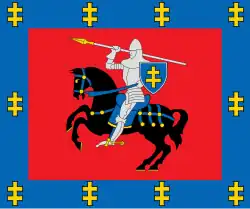Šalčininkai
Šalčininkai
Soleczniki (Polish) | |
|---|---|
City centre with monument to Adam Mickiewicz | |
 Flag 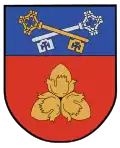 Coat of arms | |
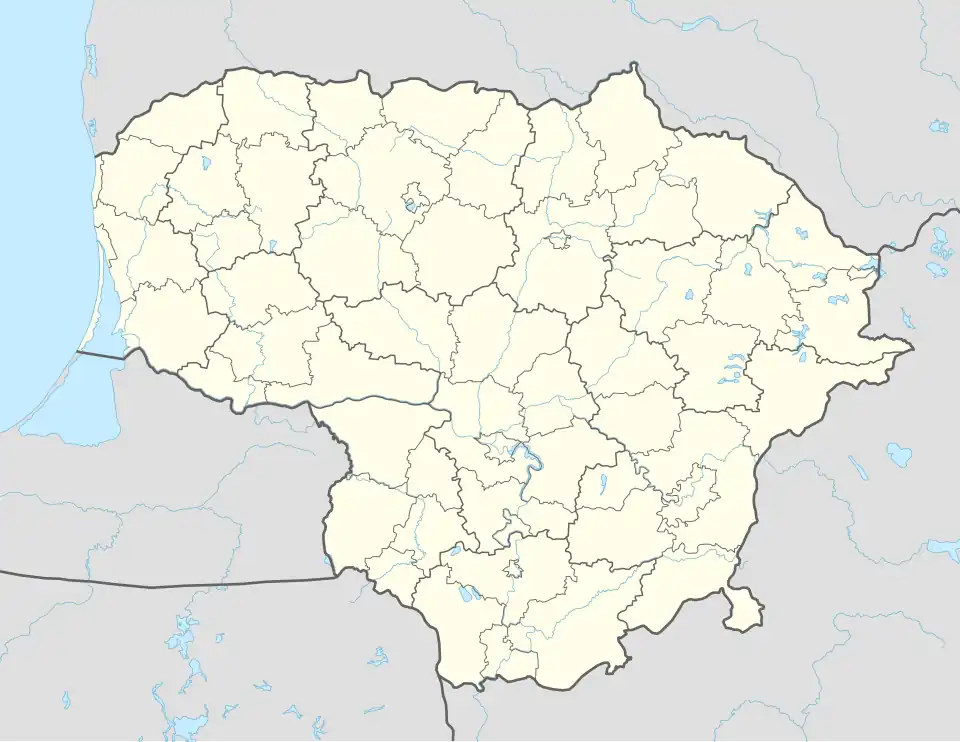 Šalčininkai Location of Šalčininkai | |
| Coordinates: 54°19′0″N 25°23′0″E / 54.31667°N 25.38333°E | |
| Country | |
| Ethnographic region | Dzūkija |
| County | |
| Municipality | Šalčininkai district municipality |
| Eldership | Šalčininkai eldership |
| Capital of | Šalčininkai district municipality Šalčininkai eldership |
| First mentioned | 1311 |
| Granted town rights | 1956 |
| Area | |
• Total | 3 km2 (1 sq mi) |
| Population (2021[1]) | |
• Total | 6,857 |
| Time zone | UTC+2 (EET) |
| • Summer (DST) | UTC+3 (EEST) |
Šalčininkai (ⓘ; Polish: Soleczniki; Yiddish: סאָלעטשניק Solechnik; Belarusian: Салечнікі) is a city in Vilnius County, in south-eastern Lithuania, situated south-east of Vilnius, near the border with Belarus.
Etymology
The name of the city derives from Šalčia river, šalta meaning cold in Lithuanian.[2]
History
.jpg)
In the medieval period the region around Šalčininkai was dominated by Lithuanians and it was the birthplace of many authors of the earliest Lithuanian-language texts (including Stanislovas Rapalionis, Jurgis Zablockis and Aleksandras Rodūnonis). In 1420, Lithuanian-speaking Nicholas of Šalčininkai was born in Šalčininkai and in 1453–1467 he served as the Bishop of Vilnius, the capital of the Grand Duchy of Lithuania.[3]
In the late 19th century many of the local inhabitants mixed with the neighbouring Belarusians and called themselves tutejszy ("the locals"), while staying Catholics, they didn't assign themselves to a single ethnic group.
The region is known for its uncodified Belarusian[4] vernacular (also known as 'po prostu', meaning 'simply' or 'plainly')[5] and the city itself is considered the provincial centre of Polish culture in Lithuania (the urban centre being Vilnius).
Šalčininkai attained the town status in 1956 and is now a capital of the Šalčininkai district municipality.
Demographics
According to the latest census of 2021, Šalčininkai had 6857 inhabitants and features a multi-ethnic population of 4930 Poles (71.9%), 920 Lithuanians (15.7%), 438 Russians (6.4%), 286 Belarusians (4.2%), 61 Ukrainians (0,9%) and 222 people of other background (3.2%). 12.2% of all inhabitants in Šalčininkai district municipality, according to the 2021 census were born abroad, while 87.8% were born in Lithuania. This was a decrease from 14.3%, recorded by the previous – 2011 census. Out of 34.5 thousand inhabitants in 2011, 3711 or 10.7% of all the inhabitants were born in Belarus, 728 or 2.1% in Russia.[6]
In 2000 coat of arms of Šalčininkai was adopted by a decree of the President of the Republic of Lithuania, designed by Arvydas Každailis, coat of arms consists of three hazelnuts symbolizing solidarity.[7]
Notable people
- Władysław Kozakiewicz (born 1950), Polish pole vaulter and Olympic champion
- Henoch Leibowitz
- Aaron Soltz
Twin towns – sister cities
Šalčininkai is twinned with:[8]
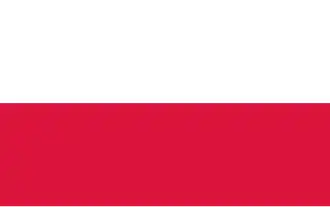 Bełchatów County, Poland
Bełchatów County, Poland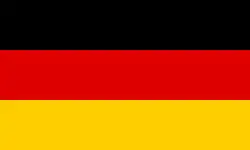 Hude, Germany
Hude, Germany Kadzidło, Poland
Kadzidło, Poland Kaźmierz, Poland
Kaźmierz, Poland Kętrzyn County, Poland
Kętrzyn County, Poland Łomża, Poland
Łomża, Poland Łowicz, Poland
Łowicz, Poland Nowe Miasto Lubawskie, Poland
Nowe Miasto Lubawskie, Poland Płońsk, Poland
Płońsk, Poland Radom County, Poland
Radom County, Poland Stare Miasto, Poland
Stare Miasto, Poland Świdnik, Poland
Świdnik, Poland Szczytno, Poland
Szczytno, Poland Tarnowo Podgórne, Poland
Tarnowo Podgórne, Poland Warsaw West County, Poland
Warsaw West County, Poland Wolsztyn County, Poland
Wolsztyn County, Poland Wschowa, Poland
Wschowa, Poland Żnin, Poland
Żnin, Poland
References
- ^ "GYVENTOJAI GYVENAMOSIOSE VIETOVĖSE" (XLSX). Osp.stat.gov.lt. Retrieved 18 July 2022.
- ^ Šalčininkų rajono miestų vardų kilmė ir kirčiavimas
- ^ Tumelis, Juozas. "Mikalojus Dziežgovskis". Visuotinė lietuvių enciklopedija (in Lithuanian). Retrieved 29 March 2025.
- ^ "Jankowiak: Po prostu for me is just a synonym of Belarusian language" – Lithuanian Polish media article – an interview with the Polish linguist on "po prostu speech
- ^ "A language which is not" – Lithuanian Russian tv series about the so-called Tutejszy phenomenon and an analysis of the speech by the linguist
- ^ Population and Housing Censuses of Lithuania, 2011, 2021
- ^ "LIETUVOS RESPUBLIKOS PREZIDENTAS DEKRETAS DĖL ŠALČININKŲ HERBO PATVIRTINIMO". infolex.lt. Retrieved 20 November 2024.
- ^ "Tarptautinis bendradarbiavimas". Salcininkai.lt (in Lithuanian). Šalčininkų rajono savivaldybė. Retrieved 2021-04-02.
